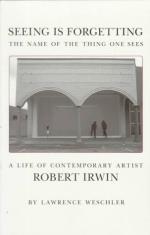
|
| Name: _________________________ | Period: ___________________ |
This quiz consists of 5 multiple choice and 5 short answer questions through Chapters 8 through 10.
Multiple Choice Questions
1. To the entrepreneur, Irwin is exceptional and thus was able to do what?
(a) Be successful in Europe.
(b) Flourish in LA and indeed anywhere.
(c) Flourish in LA.
(d) Move to New York and be successful.
2. Irwin focuses self-critique on the ______________ of the work.
(a) Balance.
(b) Movement.
(c) Unity.
(d) Form.
3. Leider felt that Irwin created the painting to be seen how?
(a) In a way that allows all viewers to have their own interpretation.
(b) As he designed it to be seen or to not be seen at all.
(c) As a magnificent work of art.
(d) As a mentally-ill person might see life.
4. That Irwin's childhood recollections reside mainly as _____________________ is a clue that his strong connection to the visual was present very early in life.
(a) Drawings he has made.
(b) Perfect images versus words or conversations.
(c) Photographs he has taken.
(d) Words or conversations versus perfect images.
5. How does Robert react when some of his work is actually destroyed by viewers at his displays?
(a) He does not mourn the loss.
(b) He sues.
(c) He becomes very angry.
(d) He falls into a depression.
Short Answer Questions
1. To Irwin, a painting's gestural integrity is unyieldingly connected to what?
2. To enhance the introspection of their processes, some of the Ferus artists become practitioners of what?
3. The genesis of Irwin's artistry is _____________.
4. A gallery displaying some of Irwin's work includes in his catalog commentary that, "The art is what has happened to __________" (p. 92).
5. With what does Ferus present Irwin?
|
This section contains 303 words (approx. 2 pages at 300 words per page) |

|




